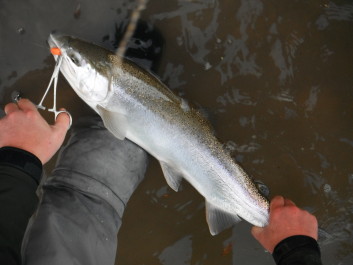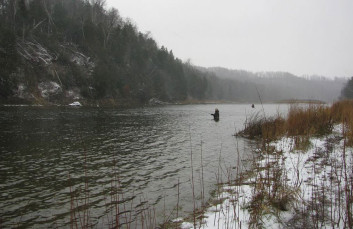Like many of our articles, this one began with a conversation with one of our customers while discussing late season tactics for Great Lakes steelhead. As many of you know, the past 10 years has seen a big shift in our philosophies when it comes to angling methods for Great Lakes steelhead and more and more guys and gals are going to the traditional swing with long rods. It seems as though there is a definite preference these days towards “the overall quality of the experience” as apposed to the “quantity game”. In other words, we are sitting back and taking a look at what makes for a more pleasant overall experience over simply shooting for numbers. As a result of the evolution of fly anglers, we tend to get past the numbers game quickly as playing in that game typically involves fishing the high profile and often grossly over crowded sections of your favorite river and we move on to the “quality” stage. Spending a day in November with a couple of friends, eating a hot shore lunch and sipping on a cold beer is what many of us are after as we mature and the fish become rather secondary.
We all love to catch steelhead and I’ll admit that after a dry spell of swinging, I’ll take out my indicator rig and join the numbers guys just to put a bend in the rod but that usually wears very thin in a hurry and I long for the solitude of my little secret haunts that may not produce as many fish but give me a better sense of being. As the swing grows in popularity, so too has the skill level of those that have picked up the long rod and the barriers that were once believed to be strong are gradually being broken down. During the conversion with our friend, he mentioned that recently and on several occasions, he was told that he was wasting his time swinging flies as the water was simply too cold. The prevailing belief has been that as the water temperatures drop, our presentation has to be slowed exponentially precipitating the shift to slow and deep indicator rigs. Although this is true, it doesn’t mean that we have to compromise and leave the swing. In fact, one can get the job done nicely if he is willing to adapt to the conditions and is not afraid to try innovative tactics that will eventually make you a more successful angler.
Here are the questions most asked of professionals when it comes to swinging flies vs. high stick nymphing.
When should I switch to my high stick rig?
The short answer is this: Let the conditions dictate. By this, we mean that in most cases, physical conditions like simply being prohibited by pressure from other anglers or fishing a river that is more conducive to high stick nymphing would precipitate the change.
Pocket water or short, deep runs often require one to get the fly down fast and keep it in the zone longer. There is no better way to do this than with a high stick nymph rig. On the other side of this is angling pressure. Some areas are simply too congested with anglers to swing flies. You require a good amount of space up and down stream of your position to effectively swing flies and work the run with purpose, so if it’s shoulder to shoulder, high stick nymphing is your best route.
How does water temperature come into play?
As water temperature drops later in the season, steelhead will become more lethargic. It doesn’t mean that they won’t take a fly but they may not want to move as far for it. In these conditions, low and slow will prevail and again, nymphing deep will often be the preferred presentation. That does not however mean that you have to abandon the swing. At this stage of the game, when water temperatures drop below 40 degrees Celsius for prolonged periods of time, steelhead will start to slow their migration and seek out what we consider “wintering water”. This water is typically large, slow, deep runs that provide good structure and cover for fish (in the way of large rocks, depressions or cut banks) that are looking at hunkering down in preparation for the ice up. If you can find this water, an appropriate sinking tip will still get a heavy fly down deep and keep it low and slow long enough to illicit a take. Just don’t expect the rod ripping grab of an October fish as the take will be very subtle. I remember a day on the lower Grand River several years ago on New Years eve when the water temperature didn’t get above 36 degrees all day. I was working a run below the Caledonia dam where I hooked and landed 4 fish in just over 3 hours all on the swing but the trick was to find the zone. You have to be willing to make changes in order to find the correct depth and this means losing a couple of flies to the bottom and changing out your tips. In these conditions, there is a fine line between being in the game and completely out of it. Always carry an assortment of tips and take the time to change them as the conditions dictate.
In the end, both methods can be effective but it depends heavily on the type of water and your ability to recognize it. Personally, I feel more confident on big water fishing the long rod with the swing, as I believe there is no better way to show your fly to more fish than methodically working the water with a down and across presentation. Conversely, smaller pocket water is often more effectively fished with a high stick nymph rig. The most successful anglers are constantly adapting to the conditions and once you have reached this stage, success will increase.
Related articles. https://ontarioflyfishing.ca/2015/09/ontario-fly-fishing-guides-secrets-to-success-covering-water-part-ii/ ,


